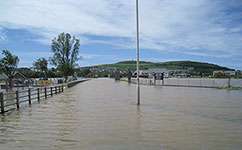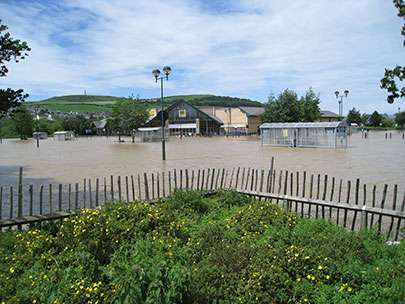Floods caused lead poisoning in UK cattle

A case of lead poisoning that killed two young cattle on a West Wales farm was caused by contaminated flood deposits, new research has revealed.
The study, published in the journal Science of the Total Environment, says the animals were poisoned when they ate silage cut from a field soon after it was inundated by lead-laden flood waters in summer 2012.
The contaminated material is thought to originate from historical metal mining in the area. Scientists say a number of river catchments throughout England and Wales face a similar risk.
Although metal mining largely stopped in Britain a century ago, some of the contaminated sediment that was washed downstream from mining sites has been stored in floodplains ever since.
When the rivers are in flood, floodplain material is eroded back into the channel. If water then overtops the banks downstream, the contaminated sediment is spread across the surrounding fields, where it can eventually find its way into animals.
'When cattle and sheep graze they can sometimes ingest small quantities of soil directly by accident,' explains Dr Paul Brewer, one of the study's authors. 'Small grains of sediment can also get stuck to the grass as the flood water recedes.'
'In 2012, a silage cut was taken soon after the water had receded and before the rain had come to wash the contaminated sediment away. Those silage bales were then stored and used in early winter to feed the cattle.'

The team at Aberystwyth University have been carrying out research on contaminated river catchments around the world since the 1980s.
In 2000, autumn floods presented them with a rare opportunity to look at the effects of flooding along the river Swale in Yorkshire. The analysis was stark, revealing lead contamination well above EU safety thresholds up to 100 kilometres downstream from the historical mine sites.
The summer of 2012 again saw widespread flooding throughout the UK, with West Wales particularly hard hit. 'We immediately saw a potential contamination risk,' says Brewer.
As the waters receded, the team sampled sites along the banks of the Rheidol, Ystwyth, Clarach and Leri in West Wales.
Again they found high levels of lead contamination, with most samples falling foul of EU guidelines. On the Clarach floodplain, samples averaged 10 times the safety limit for industrial or commercial land, with one sample measuring 82 times over.
Five months later, the team received reports of cattle falling ill after eating silage cut from the Clarach floodplain. An analysis of the bales showed that almost 40 per cent of them were contaminated beyond EU limits for animal feed and had to be removed as a feed source.
Blood samples taken from the cattle showed that all of them had lead levels beyond the safe limit for human consumption. An autopsy carried out on one of the casualty animals found lead concentrations 79 times the safe level in its kidney.
The research is the first to link floodplain contamination to lead poisoning in animals.
Brewer says several policy measures can be taken to protect cattle. 'We know where these historical mining sites are – it's just a case of land management,' he says.
'Because uptake from the soil into the growing grass plant is extremely low, if we can keep the cattle off the fields and wait to cut the silage then, in most cases, the fields will be safe to return to after a few weeks.'
Most climate models predict that the UK will become wetter and experience more flooding as the global climate warms, potentially exacerbating the problems caused by contaminated floodplains.
This winter's floods could again raise the risk of dangerous metals finding their way into rivers and onto surrounding farmland. But Brewer emphasises that it takes fast river flows, as well as flooding, to erode the contaminated material from the bank and deposit it onto the floodplain.
More information: S.A. Foulds, P.A. Brewer, M.G. Macklin, W. Haresign, R.E. Betson, S.M.E. Rassner," Flood-related contamination in catchments affected by historical metal mining: An unexpected and emerging hazard of climate change," Science of The Total Environment, Volumes 476–477, 1 April 2014, Pages 165-180, ISSN 0048-9697, dx.doi.org/10.1016/j.scitotenv.2013.12.079.
Journal information: Science of the Total Environment
Provided by PlanetEarth Online
This story is republished courtesy of Planet Earth online, a free, companion website to the award-winning magazine Planet Earth published and funded by the Natural Environment Research Council (NERC).

















